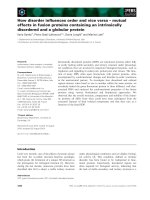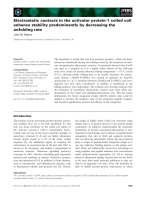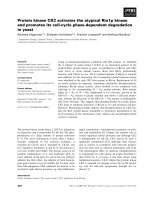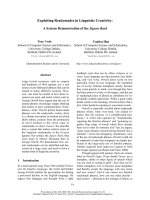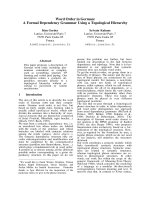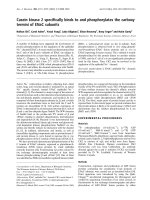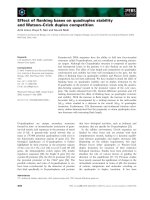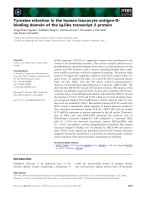Báo cáo khoa học: Protein transport in organelles: Protein transport into and across the thylakoid membrane pptx
Bạn đang xem bản rút gọn của tài liệu. Xem và tải ngay bản đầy đủ của tài liệu tại đây (215.14 KB, 10 trang )
MINIREVIEW
Protein transport in organelles: Protein transport into and
across the thylakoid membrane
Cassie Aldridge*, Peter Cain* and Colin Robinson
Department of Biological Sciences, University of Warwick, Coventry, UK
Introduction
Chloroplasts are the site of photosynthesis and other
important biochemical processes that are vital for the
functioning of plant cells. They are believed to have
arisen from a photosynthetic bacterium taken up by a
primitive eukaryotic cell. Although some of the chloro-
plast proteome is encoded by the chloroplast genome,
during endosymbiosis, most of the original prokaryotic
genome was lost or transferred to the nuclear genome;
therefore, the vast majority of chloroplast proteins are
nuclear encoded and require transport into the chloro-
plast. Whether synthesized in the cytosol or the chloro-
plast stroma, a sub-set of proteins require transport
into or across the thylakoid membranes to attain their
functional locations.
Nuclear encoded thylakoid precursor proteins are
imported across the chloroplast envelope into the chlo-
roplast stroma by a common import apparatus, namely
the Toc ⁄ Tic (translocon at the outer ⁄ inner envelope
membrane of chloroplasts) complex [1]. By contrast,
import into or across the thylakoid membrane is
thought to occur through four independent precursor-
specific thylakoid transport pathways that are descen-
dent from membrane transport systems present in the
original prokaryotic endosymbiont. These pathways
are characterized as being spontaneous, signal recogni-
tion particle (SRP)-, secretory (Sec)- or twin-arginine
translocase (Tat)-dependent. The existence of several
different thylakoid import pathways was first proposed
when analysis of the energy requirements for thylakoid
transport of several proteins showed them to be protein
Keywords
protein transport; secretory pathway; SRP;
Tat; thylakoid; twin-arginine
Correspondence
C. Robinson, Department of Biological
Sciences, University of Warwick, Coventry
CV4 7AL, UK
Fax: +44 2476 523568
Tel: +44 2476 523557
E-mail:
*These authors contributed equally to this
work
(Received 5 August 2008, revised 25
November 2008, accepted 4 December
2008)
doi:10.1111/j.1742-4658.2009.06875.x
The chloroplast thylakoid is the most abundant membrane system in nat-
ure, and is responsible for the critical processes of light capture, electron
transport and photophosphorylation. Most of the resident proteins are
imported from the cytosol and then transported into or across the thyla-
koid membrane. This minireview describes the multitude of pathways used
for these proteins. We discuss the huge differences in the mechanisms
involved in the secretory and twin-arginine translocase pathways used for
the transport of proteins into the lumen, with an emphasis on the differing
substrate conformations and energy requirements. We also discuss the
rationale for the use of two different systems for membrane protein inser-
tion: the signal recognition particle pathway and the so-called spontaneous
pathway. The recent crystallization of a key chloroplast signal recognition
particle component provides new insights into this rather unique form of
signal recognition particle.
Abbreviations
ALB3, albino 3; cp, chloroplast; EGFP, enhanced green fluorescent protein; LHCP, light-harvesting chlorophyll a ⁄ b-binding protein; OE,
oxygen evolving; Sec, secretory; SRP, signal recognition particle; Tat, twin-arginine translocase; Tic, translocon at the inner envelope
membrane of chloroplasts; Toc, translocon at the outer envelope membrane of chloroplasts; TPP, thylakoid processing peptidase.
FEBS Journal 276 (2009) 1177–1186 ª 2009 The Authors Journal compilation ª 2009 FEBS 1177
specific: transport of the 33 kDa protein of the oxy-
gen evolving complex (OE33) and plastocyanin
absolutely requires ATP [2–4]; light-harvesting chloro-
phyll a ⁄ b-binding protein (LHCP) integration requires
GTP and is stimulated by ATP [5,6]; and transport of
the 23 kDa (OE23) and 17 kDa (OE17) proteins of the
oxygen evolving complex requires only the thylakoidal
DpH [3]. Furthermore, competition studies revealed dis-
tinct precursor specific groups further demonstrating
the existence of several different pathways for thylakoid
import [1]. In the present minireview, we describe the
components and mechanisms of these four different
thylakoid import pathways.
Transport into the thylakoid lumen
Proteins destined for the thylakoid lumen are trans-
ported via the DpH ⁄ Tat and Sec-dependent pathways,
although examples of thylakoid membrane proteins
have also been reported to be transported by these
pathways. Imported Sec and Tat substrates are synthe-
sized in the cytosol with an N-terminal bipartite transit
peptide that carries two transport signals in tandem.
The amino-proximal targeting domain mediates import
of precursor proteins into the chloroplast via the Toc ⁄
Tic translocon. After transportation into the chloro-
plast, this transit peptide is cleaved off by a processing
peptidase in the stroma exposing the second transport
signal, which then mediates transport across the thyla-
koid membrane. Once across the thylakoid membrane,
this signal peptide is also cleaved off, this time by the
thylakoid processing peptidase (TPP) [7].
Thylakoid signal peptides have a broadly similar
structure for both Sec and Tat protein substrates and
are similar to prokaryotic signal sequences. They are
characterized by an N-terminal basic region, a hydro-
phobic central core and a polar C-terminal region end-
ing in an Ala-X-Ala terminal processing site. Proteins
destined to be transported by the Tat pathway contain
a characteristic pair of arginine residues in the N-ter-
minal region of the signal peptide, which gives the
pathway its name.
The Sec pathway
The chloroplast Sec pathway evolved from the general
secretory pathway involved in export of Sec-dependent
proteins to the periplasm in bacteria. In Escherichia
coli, the Sec translocon consists minimally of SecA,
SecE and SecY [8]. In the bacterial system, the signal
peptide of the preprotein interacts post-translationally
with SecA in the cytoplasm. The SecA–preprotein com-
plex associates with the Sec core components composed
of the integral membrane proteins SecY and SecE,
which are thought to form the Sec protein conducting
channel. SecA is an ATPase and drives the transloca-
tion of the protein through the Sec pore by multiple
cycles of membrane insertion and deinsertion [9].
In chloroplasts, homologues to SecA (cpSecA), SecY
(cpSecY) and SecE (cpSecE) have been identified
[10–14] and there is strong evidence that the thylakoid
membrane contains a SecAYE translocase that is func-
tionally and structurally similar to the bacterial Sec
complex: Sec transportation across thylakoid mem-
branes is dependent on ATP and is sensitive to azide
[11,15] and antibodies against cpSecY inhibit cpSecA-
dependent protein translocation, suggesting that cpSecA
and cpSecY work in concert, analogous to the situation
in bacteria [16]. Additionally, cpSecE can functionally
replace E. coli SecE [17] and the chloroplast Sec translo-
case is implicated in the co-translational insertion of
SRP-dependant proteins into the thylakoid membrane,
as it is in bacterial plasma membranes. Despite these
similarities, homologues of several other bacterial Sec
components (SecB, SecG and SecD ⁄ F) have not been
identified in chloroplasts. Similar to bacteria, transport
by the chloroplast Sec translocon requires protein sub-
strates to be in an unfolded state for transport [18,19],
as demonstrated by the inability of the chloroplast Sec
translocon to transport dihydrofolate reductase fused to
a Sec signal peptide in the presence of folate analogues
that stabilize dihydrofolate reductase in a tightly folded
form [18]. Transport of enhanced green fluorescent pro-
tein (EGFP), which spontaneously and tightly folds, is
also impossible through the chloroplast Sec translocon
[19]. In the bacterial system SecB, a cytosolic chaperone,
binds post-translationally to the mature portion of
Sec-dependent preproteins and stabilizes them in an
unfolded conformation ready for transport. Due to the
absence of a SecB homologue in chloroplasts, the identi-
ties of the stromal factors necessary to keep Sec
preproteins in an unfolded state remain elusive.
Recently, it has been shown that cpSecA ATPase
activity is stimulated by Sec-dependent thylakoid signal
peptides but not E. coli signal peptides, and that stimu-
lation of cpSecA ATPase activity requires distinct lipid
requirements different to E. coli SecA [20]. These differ-
ences suggest that cpSecA has evolved to be specifically
suited to the chloroplast thylakoid environment.
The Tat pathway
Unlike the Sec pathway, the Tat pathway requires no
stromal factors or ATP and, instead, is energized by
the trans-thylakoidal proton gradient [3,21,22]. In
addition, protein substrates can be transported in a
Protein transport across thylakoid membranes C. Aldridge et al.
1178 FEBS Journal 276 (2009) 1177–1186 ª 2009 The Authors Journal compilation ª 2009 FEBS
folded conformation, allowing the transportation of
proteins that fold too quickly or tightly for the Sec
pathway, or proteins that require the insertion of
co-factors in the stroma before transport into the thy-
lakoid lumen. This remarkable property of the Tat
pathway was first recognized during in vitro import
experiments following the observation that the OE23,
a Tat substrate, assumes a folded conformation during
its passage through the stroma [23]. Translocation of
chimeric proteins consisting of EGFP fused to the
transit peptides of the Tat substrates OE16 and OE23
have shown that the Tat pathway can also transport
folded proteins in vivo because EGFP is known to fold
quickly and spontaneously and cannot be transported
through the Sec pathway [19]. However, in contrast to
bacterial Tat proteins where protein folding appears to
be a prerequisite to Tat transport, folding is not
required for translocation of Tat substrates in chlorop-
lasts [18]. Figure 1 summarizes the differing mecha-
nisms of the Sec and Tat pathways in chloroplasts.
The Tat pathway in chloroplasts consists of the inte-
gral membrane proteins Tha4 [16,24], Hcf106 [25] and
cpTatC [26], which are closely related to their bacterial
counterparts, designated TatA, TatB and TatC, respec-
tively. Tha4 and Hcf106 are single-span membrane
proteins containing an N-terminal transmembrane
domain followed by a short amphipathic helical region
and an unstructured stromal C-terminal domain. Stud-
ies have shown that the C-terminal domain is dispens-
able for Tha4 function but the transmembrane domain
and amphipathic helix are essential for function [27].
TatC is predicted to contain six transmembrane
domains with both the amino and carboxyl termini
protruding into the stroma. Similar to their bacterial
counterparts, Tha4, Hcf106 and cpTatC exist in the
membrane as two sub-complexes: cpTatC and Hcf106
form an approximately 700 kDa receptor complex [28]
and Tha4 oligomers form separate complexes that
associate with the receptor complex under conditions
of protein transport (i.e. in the presence of bound pre-
cursor and a trans-thylakoidal proton gradient)
[29,30]. The transport of proteins by the Tat pathway
can be divided approximately into several stages, as
illustrated in Fig. 2: (i) the precursor protein binds to
a cpTatC-Hcf106 receptor complex; (ii) precursor bind-
ing stimulates assembly of Tha4 oligomers with the
precursor–receptor complex and the putative translo-
Tat pathway Sec pathway
Stroma
Lumen
cpTatC
Tha4
Hcf106
SecY
SecE
SecA
SecA
Fig. 1. Basic features of the Sec and Tat pathways used for the
translocation of lumenal proteins across the thylakoid membrane.
Both types of substrate bear cleavable N-terminal signal peptides,
depicted as black rectangles. The Tat pathway involves Hcf106 and
cpTatC, which are believed to form a receptor complex that recog-
nizes Tat signal peptides, and Tha4, which interacts transiently with
the precursor ⁄ receptor complex during transport and is thought to
form part of a pore for Tat protein transport. Tat substrates are
transported in a fully folded form and use the thylakoid proton gra-
dient to provide energy for translocation. By contrast, Sec substrate
proteins are transported in an unfolded conformation in a process
that requires ATP. Sec transport minimally involves SecA (an
ATPase) and the membrane-bound SecE and SecY subunits. SecA
ATPase activity provides the energy to drive the translocation of
proteins through the SecE ⁄ Y pore. After translocation, the signal
peptides of both Tat and Sec substrates are removed by the thyla-
koid processing peptidase (represented as scissors).
Stroma
Lumen
Tha4
cpTatC-
Hcf106
Precursor
(ii) Tha4 assembly
TPP
(iii) Protein translocation
Tha4
TPP clevage
disassociation
(i) Precursor binding
Proton gradient
Fig. 2. Mechanism of the Tat system. (i) The precursor protein
binds through the signal peptide to a cpTatC-Hcf106 receptor com-
plex in the thylakoid membrane. (ii) Precursor binding in the pres-
ence of DpH stimulates assembly of Tha4 oligomers with the
precursor–receptor complex and the putative translocase is formed.
(iii) The precursor protein is then transported in a process energized
by the DpH across the thylakoid membranes. The transported pro-
tein is released from the translocase into the lipid bilayer, where
the signal peptide is removed by the TPP and the mature protein is
released into the lumen. After protein transport, Tha4 dissociates
from the receptor complex and the system is reset.
C. Aldridge et al. Protein transport across thylakoid membranes
FEBS Journal 276 (2009) 1177–1186 ª 2009 The Authors Journal compilation ª 2009 FEBS 1179
case is formed; and (iii), the precursor is transported
and released from the translocase into the lipid bilayer
where the signal peptide is removed and the mature
protein is released into the lumen. After protein trans-
port, Tha4 dissociates from the receptor complex and
the system is reset.
It is believed that Tha4 forms at least part of a pro-
tein conducting channel. Cross-linking studies have
shown that Tha4 undergoes conformational rearrange-
ment during active protein transport, with the amphi-
pathic helix and C-terminal tail interacting only in
response to conditions leading to protein transport
[30]. The Tat translocon needs to transport proteins of
varying size without leakage of ions across the mem-
brane and therefore some degree of flexibility is
required to form adaptable pores to accommodate dif-
ferent proteins. Analysis of E. coli TatA using single-
particle electron microscopy reveals that TatA forms
ring-shaped structures of variable diameter [31], sup-
porting a model in which Tha4 ⁄ TatA form a pore-like
channel and Tha4 oligomerization and recruitment of
Tha4 can be tailored to the size of the protein to be
transported.
The cpTatC-Hcf106 complex forms the receptor for
Tat substrates and both Tat subunits were found to
interact with the protein precursor [28]; cross-linking
studies found that cpTatC and Hcf106 interact with
different regions of the signal peptide. cpTatC cross-
links strongly to residues in the immediate vicinity of
the twin arginine motif, whereas Hcf106 cross-links
less strongly to residues in the hydrophobic core and
the early mature protein [32]. Binding of the precursor
can occur in the absence of DpH [33] but the thylakoid
proton gradient induces a tighter interaction between
the signal peptide and cpTatC and Hcf106 such that,
during transport, the signal peptide is bound deep
within the Tat receptor complex [34]. Although the
cpTatC-Hcf106 acts as a receptor for the Tat complex,
Tat-dependent transport may be initiated by the unas-
sisted insertion of the substrate into the lipid bilayer
and subsequent interaction with the Tat translocase
may take place only in later stages of the translocation
process [35]. Analysis of the chimeric 16 ⁄ 23 precursor
polypeptide, which consists of the transit peptide from
OE16 fused to the mature OE23 protein, presents an
alternative model for the interaction of the preprotein
with the receptor. The 16 ⁄ 23 chimera is retarded dur-
ing translocation; early in the process, the protein
assumes a structure within the membrane in which the
N-terminus and C-terminus are both exposed to the
stroma. The formation of this early intermediate does
not depend on a functional Tat translocase [36]. Subse-
quently, the C-terminal domain is fully translocated in
a Tat dependent manner and the signal peptide is
removed by the TPP and the mature polypeptide is
released into the thylakoid lumen.
Although several studies have demonstrated the
requirement for DpH in Tat transport in vitro, Finazzi
et al. [37] demonstrated that elimination of the trans-
thylakoidal DpH in vivo in Chlamydomonas reinhardtii
had no effect on thylakoid targeting of Tat passenger
proteins. It was suggested that, in vivo, the chloroplast
Tat pathway may also utilize the transmembrane elec-
tric potential as an energy source [38]; however, the
efficiency of translocation of OE23 is undiminished in
the absence of DpH and ⁄ or DW in tobacco protoplasts
[39]. It has recently been reported that the Tat path-
way can also transport substrates in the dark [40]. It
was suggested that the thylakoid proton motive force
is present long after actinic illumination of the thylak-
oids ceases and this may be achieved through a pool
of protons in the thylakoid held out of equilibrium
with those in the bulk aqueous phase. Clearly, the dif-
ferences in energetic requirements between in vitro and
in vivo experiments require further study and may
result from unknown factors present in vivo but miss-
ing from in vitro experiments.
Transport into the thylakoid membrane
Nuclear encoded proteins destined to be inserted into
the thylakoid membrane are transported by either an
assisted, SRP-dependent pathway or by an unassisted,
possibly spontaneous insertion route (Fig. 3). Traffick-
ing of proteins to the thylakoid membrane occurs on
a substantial scale and is essential for thylakoid
biogenesis.
The cpSRP pathway
Classical SRP systems can be found in the cytoplasm
of both prokaryotes and eukaryotes. These systems are
co-translational and rely on the presence of the ribo-
some and a highly conserved RNA component [41]. In
higher-plant chloroplasts, a unique post-translational
SRP pathway has been identified in a system that tar-
gets proteins into the thylakoid membrane but has no
RNA requirement [42].
The post-translational cpSRP transport pathway has
a narrow range of closely-related substrates that are all
members of the abundant LHCP family [43]. These
pigment-binding proteins are found in the thylakoid
membrane system of chloroplasts and form compo-
nents of the light-harvesting antenna complexes. LHCP
(Lhcb1) is the most studied of the cpSRP transport
substrates. It is highly hydrophobic, composed of three
Protein transport across thylakoid membranes C. Aldridge et al.
1180 FEBS Journal 276 (2009) 1177–1186 ª 2009 The Authors Journal compilation ª 2009 FEBS
trans-membrane a-helices (TM1-3) that bind both
chlorophylls and carotenoid pigments [44]. LHCP is
synthesized in the cytoplasm as a precursor protein,
which includes an N-terminal transit peptide that
mediates chloroplast targeting [45]. After chloroplast
import, LHCP is targeted to the thylakoid membrane.
Unlike other chloroplast routing pathways, such as
Tat and Sec that require a bipartite signal peptide, the
thylakoid targeting sequence of cpSRP substrates is
located within the mature span of the protein [46].
In the stroma, LHCP associates with cpSRP to
form the ‘transit complex’ [47]. Within the transit
complex, two SRP subunits (cpSRP54 and cpSRP43)
are present in addition to LHCP. cpSRP54 has
strong homology to both the fifty-four homologue
SRP subunit of prokaryotes and the SRP54 subunit
of the eukaryotic SRP system [42,48]. However,
although homologous, cpSRP54 is not functionally
equivalent to these cytoplasmic forms in complemen-
tation studies [49]. The second subunit, cpSRP43, has
no known homologues. This novel subunit was con-
firmed by peptide analysis to be the Cao (CHAOS)
gene product [47]. Closer analysis of cpSRP54 reveals
that it has GTPase activity, which suggests a role in
thylakoid insertion events [42]. This GTPase activity
is due to an N-terminal domain called the GTPase-
containing domain (G-domain). CpSRP54 also has a
second domain designated the methionine-rich
domain (M-domain) [48].
Within cpSRP43, two domain structures have been
defined. The first of these are chromo (chromosome
organization modifier) domains, of which three have
been identified in cpSRP43. The first chromodomain
(CD1) is located in the N-terminal region [50]. The
remaining two chromodomains (CD2 and CD3) are
located at the C-terminus of cpSRP43 [51]. The struc-
tures of all three chromodomains have been deter-
mined using triple resonance NMR experiments [52].
The second domain structures are four sequential
ankyrin repeats that are located between CD1 and
CD2 ⁄ CD3 [51]. These ankyrin repeats (ANK 1–4) have
been implicated in protein–protein interactions and are
likely to be involved in complex formation. Recently, a
high resolution crystal structure of cpSRP43 has been
solved [53]. Formation of the stromal transit complex
requires a series of specific recognition and interaction
events between the LHCP substrate and the cpSRP
subunits. Binding between LHCP and cpSRP43 is med-
iated by a conserved 18 amino acid span, termed L18,
positioned between TM2 and TM3 of LHCP [54]. As
seen from the crystal structure, L18 fits a groove
formed by ANK2-4 of cpSRP43. An essential ‘DPLG’
motif within L18 is critically important in this interac-
tion where it interacts with a tyrosine of ANK3 [53].
Previously, it had been suggested that L18 binding to
cpSRP43 occurs through the first ankyrin repeat [55].
As with cpSRP43, cpSRP54 also binds directly to
LHCP within the transit complex [42]. TM3 has been
shown to be particularly important in this binding but
it is not clear whether functional interactions also
occur with the other TM spans [42,56].
Between the cpSRP subunits, the C-terminal located
M-domain of cpSRP54 was identified as the cpSRP43
binding site [55]. Interaction between cpSRP54 and
cpSRP43 was localized to a highly positively charged
segment of ten amino acids of cpSRP54. Furthermore,
the cpSRP43 binding site was found to be conserved
in all cpSRP54 proteins and absent from cytoplasmic
homologues [57]. Mutational analysis of cpSRP43
reveals that CD2 is responsible for cpSRP54 binding
[52,58]. When this interaction was examined quantita-
tively by surface plasmon resonance, binding of
cpSRP54 to the CD2 region alone was less efficient
than binding to the full-length cpSRP43, suggesting
that other regions of interaction remain uncharacter-
ized [59]. Within CD2, the potential role of the nega-
tively charged C-terminal a-helix in cpSRP54
interactions has been highlighted [52,59]. Further stud-
ies suggest that CD2 undergoes a conformational
change upon binding cpSRP54 [60].
Stroma
Lumen
cpSRP pathway Spontaneous pathway
Alb3
cpFtsY
cpSRP54
cpSRP43
Fig. 3. SRP-dependent and ‘spontaneous’ pathways for the inser-
tion of thylakoid membrane proteins. In the cpSRP-dependent path-
way, members of the LHCP family are imported into the
chloroplast where they bind to cpSRP (a heterodimer of SRP43 and
SRP54 subunits) in the stroma. This complex then interacts with
cpFtsY and the LHCP is inserted into the thylakoid membrane by
a mechanism that requires ALB3, a member of the YidC ⁄ Oxa1
family. Other thylakoid membrane proteins use an alternative inser-
tion pathway that does not require any source of free energy or
any of the known targeting apparatus. These proteins may there-
fore insert spontaneously, although the possible involvement of
other, as yet unidentified factors cannot be excluded at present.
C. Aldridge et al. Protein transport across thylakoid membranes
FEBS Journal 276 (2009) 1177–1186 ª 2009 The Authors Journal compilation ª 2009 FEBS 1181
After transit complex assembly, a third protein,
cpFtsY, has a role in the cpSRP pathway where cpFtsY
is assumed to target the transit complex to the thyla-
koid membrane. CpFtsY was discovered in an attempt
to find homologues of the eukaryotic SRP receptor,
SRa, and the prokaryotic FtsY [61]. The exact parti-
tioning of cpFtsY between the stroma and thylakoid
membrane is unclear and may be transient in nature,
which could reflect its predicted role in membrane
targeting, but the majority of cpFtsY is found on the
stromal face of the thylakoid membrane [61]. Within
the cpFtsY NG domain, the three domains for GTP
binding are conserved [61]. The crystal structure of
cpFtsY has been determined and demonstrates how the
NG domain arrangement may contribute to efficient
cpSRP54 ⁄ cpFtsY interactions in the absence of an
RNA component [62,63]. In addition, a membrane tar-
geting sequence has been defined in an extended region
of the NG domain [63]. A combination of cpSRP43,
cpSRP54 and cpFtsY reconstitute the stromal activity
in LHCP membrane insertion, hence confirming that
no other stromal components are required [6,64].
The insertion of LHCP into the thylakoid membrane
is probably one of the least well characterized stages in
the cpSRP pathway. An integral, multi-spanning pro-
tein termed Albino 3 (ALB3) is involved and is a chlo-
roplast homologue of the mitochondrial translocon
component, Oxa1p. Mutants that are deficient in
ALB3 have an albino phenotype and display clear defi-
ciencies in thylakoid biosynthesis [65,66]. Evidence
exists of an interaction between ALB3 and the cpSecY
translocase and, furthermore, this interaction has been
attributed to interactions by the C-terminal region of
ALB3 [67]. It is not known whether this finding is
related to a functional interaction, and hence a poten-
tial role for cpSecY in cpSRP-mediated LHCP inser-
tion [68]. This cpSecY interaction is perhaps an
indication that the role of ALB3 extends beyond
cpSRP substrate insertion to a wider role involving
thylakoid membrane proteins.
In addition to the proteinatious requirements for the
cpSRP pathway, there is also a less well understood
nucleotide requirement. This is likely to occur during
insertion events because the formation of the transit
complex can take place in the absence of nucleotides
[69]. For successful membrane insertion of LHCP,
GTP hydrolysis is essential [5]. A role for GTP hydro-
lysis is likely in steps preceding or directly involving
dissociation of the cpSRP complex from the mem-
brane-bound state [68,70]. ATP has been shown to
have an alternate and possibly regulatory role because
it stimulates integration of LHCP into the membrane
in a mechanism that is independent of the DpH [6].
Intriguingly, some interesting phenotypes have
emerged in studies on cpSRP mutants. It has been sug-
gested that cpSRP43 can function alone, in LHCP
insertion, if both cpSRP54 and cpFtsY are absent [71].
It is clear that additional studies are required in this
area to resolve these findings.
Spontaneous insertion pathway
The spontaneous (unassisted) pathway for thylakoid
membrane proteins was first suggested to describe the
insertion of the single-membrane-spanning CFoII sub-
unit of the ATP synthase [72]. The insertion of CFoII
was described as having no requirement for nucleotides
or for proteinaceous insertion machinery. Other single-
spanning proteins have also been suggested to use this
membrane integration route, including the photosys-
tem II subunits, PsbW and PsbX. In describing these
insertion characteristics, parallels were drawn to the
insertion of the M13 procoat protein in E. coli, which
was also supposedly spontaneous in insertion. How-
ever, it was subsequently shown that an integral mem-
brane insertase, YidC, was actually important in its
insertion, hence questioning a truly spontaneous mech-
anism in bacteria [73]. Inactivation of the chloroplast
YidC homologue ALB3 did not affect the thylakoid
membrane insertion of PsbW and PsbX; therefore, it
appears that insertion of these proteins may be truly
independent of any form of translocation apparatus
[74].
Spontaneous insertion has also been attributed to
more topologically complex proteins. The closely-
related photosystem I components, PsaK and PsaG,
are both observed to insert into the membrane with
two trans-membrane spans, connected by a stroma-
exposed loop [75,76]. For PsaG, the influence of posi-
tive charges in the loop region was further analysed
and it was found they are essential for insertion and
function [75]. In the case of PsbY, a complex series of
proteolytic events occurs as the precursor is converted
into two individual membrane spans, A1 and A2 [77].
Other multi-spanning proteins have also been sug-
gested to insert spontaneously, including PsbS and
ELIP2. In addition, the SecE subunit of the Sec
translocase and the Hcf106 ⁄ Tha4 subunits of the Tat
translocase appear to use this spontaneous insertion
mechanism [78].
Conclusions
It is clear that protein import into thylakoids occurs,
through a variety mechanisms, via functionally inde-
pendent pathways that have significant similarity to
Protein transport across thylakoid membranes C. Aldridge et al.
1182 FEBS Journal 276 (2009) 1177–1186 ª 2009 The Authors Journal compilation ª 2009 FEBS
bacterial transport systems. These pathways have been
termed spontaneous, cpSRP, Sec and Tat. Although it
is probable that all of the essential components of the
cpSec, cpTat and cpSRP pathways have been identi-
fied, the exact mechanism for each of these pathways
remains largely unknown and clearly requires further
investigation.
In bacteria, much work has been performed aiming
to characterize the Sec pathway, whereas, in chlorop-
lasts, our knowledge of the cpSec pathway is limited,
with current models being mainly based on homology
to the bacterial Sec system. Although there are obvious
parallels between bacterial and chloroplast Sec sys-
tems, several components of the bacterial Sec appara-
tus have not been identified in chloroplasts. Therefore,
caution is warranted in assuming that these systems
operate in the same manner, and further experimental
studies are required to elucidate the exact mechanistic
details of the chloroplast Sec pathway.
The mechanism of the Tat pathway still remains to
be determined in both bacteria and chloroplasts.
Although evidence indicates that Tha4 ⁄ TatA oligomers
form a pore for protein conveyance, this remains to be
confirmed. Clearly, in this situation, structural infor-
mation about the Tat complex and its individual com-
ponents will prove invaluable.
In the field of cpSRP, much progress has been
recently made with respect to crystallizing various
cpSRP components and defining their interaction
domains. However, the exact method of thylakoid
membrane insertion is not well understood. The inser-
tion process is believed to involve ALB3; however, the
precise role of ALB3 remains unclear. Investigation of
the role of ALB3 would allow a more complete picture
of SRP-dependent thylakoid import.
References
1 Cline K, Henry R, Li C & Yuan J (1993) Multiple
pathways for protein transport into or across the thyla-
koid membrane. EMBO J 12, 4105–4114.
2 Bauerle C & Keegstra K (1991) Full-length plastocyanin
precursor is translocated across isolated thylakoid mem-
branes. J Biol Chem 266, 5876–5883.
3 Cline K, Ettinger WF & Theg SM (1992) Protein-
specific energy requirements for protein transport across
or into thylakoid membranes. Two lumenal proteins are
transported in the absence of ATP. J Biol Chem 267,
2688–2696.
4 Kirwin PM, Meadows JW, Shackleton JB, Musgrove
JE, Elderfield PD, Mould R, Hay NA & Robinson C
(1989) ATP-dependent import of a lumenal protein by
isolated thylakoid vesicles. EMBO J 8, 2251–2255.
5 Hoffman NE & Franklin AE (1994) Evidence for a
stromal GTP requirement for the integration of a chlo-
rophyll a ⁄ b-binding polypeptide into thylakoid mem-
branes. Plant Physiol 105, 295–304.
6 Yuan J, Kight A, Goforth RL, Moore M, Peterson EC,
Sakon J & Henry R (2002) ATP stimulates signal recog-
nition particle (SRP) ⁄ FtsY-supported protein integra-
tion in chloroplasts. J Biol Chem 277, 32400–32404.
7 Halpin C, Elderfield PD, James HE, Zimmermann R,
Dunbar B & Robinson C (1989) The reaction specifici-
ties of the thylakoidal processing peptidase and Escheri-
chia coli leader peptidase are identical. EMBO J 8,
3917–3921.
8 Akimaru J, Matsuyama S, Tokuda H & Mizushima S
(1991) Reconstitution of a protein translocation system
containing purified SecY, SecE, and SecA from Escheri-
chia coli. Proc Natl Acad Sci USA 88, 6545–6549.
9 Dalbey RE & Chen M (2004) Sec-translocase mediated
membrane protein biogenesis. Biochim Biophys Acta
1694, 37–53.
10 Nakai M, Goto A, Nohara T, Sugita D & Endo T
(1994) Identification of the SecA protein homolog in
pea chloroplasts and its possible involvement in thylak-
oidal protein transport. J Biol Chem 269, 31338–31341.
11 Yuan J, Henry R, McCaffery M & Cline K (1994) SecA
homolog in protein transport within chloroplasts: evi-
dence for endosymbiont-derived sorting. Science 266,
796–798.
12 Laidler V, Chaddock AM, Knott TG, Walker D &
Robinson C (1995) A SecY homolog in Arabidopsis tha-
liana. Sequence of a full-length cDNA clone and import
of the precursor protein into chloroplasts. J Biol Chem
270, 17664–17667.
13 Roy LM & Barkan A (1998) A SecY homologue is
required for the elaboration of the chloroplast thylakoid
membrane and for normal chloroplast gene expression.
J Cell Biol 141, 385–395.
14 Schuenemann D, Amin P, Hartmann E & Hoffman NE
(1999) Chloroplast SecY is complexed to SecE and
involved in the translocation of the 33-kDa but not the
23-kDa subunit of the oxygen-evolving complex. J Biol
Chem 274, 12177–12182.
15 Hulford A, Hazell L, Mould RM & Robinson C (1994)
Two distinct mechanisms for the translocation of pro-
teins across the thylakoid membrane, one requiring the
presence of a stromal protein factor and nucleotide
triphosphates. J Biol Chem 269, 3251–3256.
16 Mori H, Summer EJ, Ma X & Cline K (1999) Compo-
nent specificity for the thylakoidal Sec and Delta
pH-dependent protein transport pathways. J Cell Biol
146
, 45–56.
17 Froderberg L, Rohl T, van Wijk KJ & de Gier JW
(2001) Complementation of bacterial SecE by a chloro-
plastic homologue. FEBS Lett 498, 52–56.
C. Aldridge et al. Protein transport across thylakoid membranes
FEBS Journal 276 (2009) 1177–1186 ª 2009 The Authors Journal compilation ª 2009 FEBS 1183
18 Hynds PJ, Robinson D & Robinson C (1998) The sec-
independent twin-arginine translocation system can
transport both tightly folded and malfolded proteins
across the thylakoid membrane. J Biol Chem 273,
34868–34874.
19 Marques JP, Schattat MH, Hause G, Dudeck I & Klos-
gen RB (2004) In vivo transport of folded EGFP by the
DeltapH ⁄ TAT-dependent pathway in chloroplasts of
Arabidopsis thaliana. J Exp Bot 55, 1697–1706.
20 Sun C, Rusch SL, Kim J & Kendall DA (2007) Chloro-
plast SecA and Escherichia coli SecA have distinct lipid
and signal peptide preferences. J Bacteriol 189, 1171–
1175.
21 Mould RM & Robinson C (1991) A proton gradient is
required for the transport of two lumenal oxygen-evolv-
ing proteins across the thylakoid membrane. J Biol
Chem 266, 12189–12193.
22 Klosgen RB, Brock IW, Herrmann RG & Robinson C
(1992) Proton gradient-driven import of the 16 kDa
oxygen-evolving complex protein as the full precursor
protein by isolated thylakoids. Plant Mol Biol 18, 1031–
1034.
23 Creighton AM, Hulford A, Mant A, Robinson D &
Robinson C (1995) A monomeric, tightly folded stromal
intermediate on the delta pH-dependent thylakoidal
protein transport pathway. J Biol Chem 270, 1663–
1669.
24 Walker MB, Roy LM, Coleman E, Voelker R &
Barkan A (1999) The maize tha4 gene functions in
sec-independent protein transport in chloroplasts and
is related to hcf106, tatA, and tatB. J Cell Biol 147,
267–276.
25 Settles AM, Yonetani A, Baron A, Bush DR, Cline K
& Martienssen R (1997) Sec-independent protein trans-
location by the maize Hcf106 protein. Science 278,
1467–1470.
26 Mori H, Summer EJ & Cline K (2001) Chloroplast
TatC plays a direct role in thylakoid (Delta)pH-depen-
dent protein transport. FEBS Lett 501, 65–68.
27 Dabney-Smith C, Mori H & Cline K (2003) Require-
ment of a Tha4-conserved transmembrane glutamate in
thylakoid Tat translocase assembly revealed by
biochemical complementation. J Biol Chem 278,
43027–43033.
28 Cline K & Mori H (2001) Thylakoid DeltapH-depen-
dent precursor proteins bind to a cpTatC-Hcf106 com-
plex before Tha4-dependent transport. J Cell Biol 154,
719–729.
29 Mori H & Cline K (2002) A twin arginine signal pep-
tide and the pH gradient trigger reversible assembly of
the thylakoid [Delta]pH ⁄ Tat translocase. J Cell Biol
157, 205–210.
30 Dabney-Smith C, Mori H & Cline K (2006) Oligomers
of Tha4 organize at the thylakoid Tat translocase dur-
ing protein transport. J Biol Chem 281, 5476–5483.
31 Gohlke U, Pullan L, McDevitt CA, Porcelli I, de Leeuw
E, Palmer T, Saibil HR & Berks BC (2005) The TatA
component of the twin-arginine protein transport sys-
tem forms channel complexes of variable diameter. Proc
Natl Acad Sci USA 102, 10482–10486.
32 Gerard F & Cline K (2006) Efficient twin arginine
translocation (Tat) pathway transport of a precursor
protein covalently anchored to its initial cpTatC bind-
ing site. J Biol Chem 281, 6130–6135.
33 Ma X & Cline K (2000) Precursors bind to specific sites
on thylakoid membranes prior to transport on the delta
pH protein translocation system. J Biol Chem 275,
10016–10022.
34 Gerard F & Cline K (2007) The thylakoid proton gradi-
ent promotes an advanced stage of signal peptide bind-
ing deep within the Tat pathway receptor complex.
J Biol Chem 282, 5263–5272.
35 Hou B, Frielingsdorf S & Klosgen RB (2006) Unas-
sisted membrane insertion as the initial step in Del-
tapH ⁄ Tat-dependent protein transport. J Mol Biol 355,
957–967.
36 Berghofer J & Klosgen RB (1999) Two distinct
translocation intermediates can be distinguished during
protein transport by the TAT (Deltaph) pathway
across the thylakoid membrane. FEBS Lett 460, 328–
332.
37 Finazzi G, Chasen C, Wollman FA & de Vitry C
(2003) Thylakoid targeting of Tat passenger proteins
shows no delta pH dependence in vivo. EMBO J 22,
807–815.
38 Braun NA, Davis AW & Theg SM (2007) The chloro-
plast Tat pathway utilizes the transmembrane electric
potential as an energy source. Biophys J 93, 1993–1998.
39 Di Cola A, Bailey S & Robinson C (2005) The thyla-
koid delta pH ⁄ delta psi are not required for the initial
stages of Tat-dependent protein transport in tobacco
protoplasts. J Biol Chem 280, 41165–41170.
40 Braun NA & Theg SM (2008) The cpTat pathway
transports substrates in the dark. J Biol Chem 283,
8822–8826.
41 Luirink J & Sinning I (2004) SRP-mediated protein tar-
geting: structure and function revisited. Biochim Biophys
Acta 1694, 17–35.
42 Li X, Henry R, Yuan J, Cline K & Hoffman NE (1995)
A chloroplast homologue of the signal recognition par-
ticle subunit SRP54 is involved in the posttranslational
integration of a protein into thylakoid membranes. Proc
Natl Acad Sci USA 92, 3789–3793.
43 Klimmek F, Sjodin A, Noutsos C, Leister D & Jansson
S (2006) Abundantly and rarely expressed Lhc protein
genes exhibit distinct regulation patterns in plants. Plant
Physiol 140, 793–804.
44 Kuhlbrandt W, Wang DN & Fujiyoshi Y (1994)
Atomic model of plant light-harvesting complex by elec-
tron crystallography. Nature 367, 614–621.
Protein transport across thylakoid membranes C. Aldridge et al.
1184 FEBS Journal 276 (2009) 1177–1186 ª 2009 The Authors Journal compilation ª 2009 FEBS
45 Cashmore AR (1984) Structure and expression of a pea
nuclear gene encoding a chlorophyll a ⁄ b-binding poly-
peptide. Proc Natl Acad Sci USA 81, 2960–2964.
46 Viitanen PV, Doran ER & Dunsmuir P (1988) What is
the role of the transit peptide in thylakoid integration
of the light-harvesting chlorophyll a ⁄ b protein? J Biol
Chem 263, 15000–15007.
47 Schuenemann D, Gupta S, Persello-Cartieaux F, Kli-
myuk VI, Jones JDG, Nussaume L & Hoffman NE
(1998) A novel signal recognition particle targets light-
harvesting proteins to the thylakoid membranes. Proc
Natl Acad Sci USA 95, 10312–10316.
48 Franklin AE & Hoffman NE (1993) Characterization of
a chloroplast homologue of the 54-kDa subunit of the
signal recognition particle but no evidence for a post-
translational role. J Biol Chem 268, 22175–22180.
49 Schuenemann D, Amin P & Hoffman NE (1999) Func-
tional divergence of the plastid and cytosolic forms of
the 54-kDa subunit of signal recognition particle. Bio-
chem Biophys Res Commun 254, 253–258.
50 Eichacker LA & Henry R (2001) Function of a chloro-
plast SRP in thylakoid protein export. Biochim Biophys
Acta 1541, 120–134.
51 Klimyuk VI, Persello-Cartieaux F, Havaux M, Con-
tard-David P, Schuenemann D, Meiherhoff K, Gouet
P, Jones JD, Hoffman NE & Nussaume L (1999) A
chromodomain protein encoded by the arabidopsis
CAO gene is a plant-specific component of the chloro-
plast signal recognition particle pathway that is
involved in LHCP targeting. Plant Cell 11, 87–99.
52 Sivaraja V, Kumar TK, Leena PS, Chang AN, Vidya
C, Goforth RL, Rajalingam D, Arvind K, Ye JL, Chou
J et al. (2005) Three-dimensional solution structures of
the chromodomains of cpSRP43. J Biol Chem 280,
41465–41471.
53 Stengel KF, Holdermann I, Cain P, Robinson C, Wild
K & Sinning I (2008) Structural basis for specific sub-
strate recognition by the chloroplast signal recognition
rarticle protein cpSRP43. Science 321, 253–256.
54 Tu CJ, Peterson EC, Henry R & Hoffman NE (2000)
The L18 domain of light-harvesting chlorophyll proteins
binds to chloroplast signal recognition particle 43.
J Biol Chem 275, 13187–13190.
55 Jonas-Straube E, Hutin C, Hoffman NE & Schune-
mann D (2001) Functional analysis of the protein-inter-
acting domains of chloroplast SRP43. J Biol Chem 276,
24654–24660.
56 High S, Henry R, Mould RM, Valent Q, Meacock S,
Cline K, Gray JC & Luirink J (1997) Chloroplast
SRP54 interacts with a specific subset of thylakoid pre-
cursor proteins – some crosslinking. J Biol Chem 272,
11622–11628.
57 Funke S, Knechten T, Ollesch J & Schunemann D
(2005) A unique sequence motif in the 54-kDa subunit
of the chloroplast signal recognition particle mediates
binding to the 43-kDa subunit. J Biol Chem 280, 8912–
8917.
58 Goforth RL, Peterson EC, Yuan J, Moore MJ, Kight
AD, Lohse MB, Sakon J & Henry RL (2004) Regula-
tion of the GTPase cycle in post-translational signal rec-
ognition particle-based protein targeting involves
cpSRP43. J Biol Chem 279, 43077–43084.
59 Hermkes R, Funke S, Richter C, Kuhlmann J &
Schunemann D (2006) The alpha-helix of the second
chromodomain of the 43 kDa subunit of the chloroplast
signal recognition particle facilitates binding to the
54 kDa subunit. FEBS Lett 580, 3107–3111.
60 Kathir KM, Rajalingam D, Sivaraja V, Kight A,
Goforth RL, Yu C, Henry R & Kumar T (2008)
Assembly of chloroplast signal recognition particle
involves structural rearrangement in cpSRP43. J Mol
Biol
381, 49–60.
61 Kogata N, Nishio K, Hirohashi T, Kikuchi S & Nakai
M (1999) Involvement of a chloroplast homologue of
the signal recognition particle receptor protein, FtsY, in
protein targeting to thylakoids. FEBS Lett 447, 329–333.
62 Chandrasekar S, Chartron J, Jaru-Ampornpan P &
Shan SO (2008) Structure of the chloroplast signal rec-
ognition particle (SRP) receptor: domain arrangement
modulates SRP-receptor interaction. J Mol Biol 375,
425–436.
63 Stengel KF, Holdermann I, Wild K & Sinning I (2007)
The structure of the chloroplast signal recognition parti-
cle (SRP) receptor reveals mechanistic details of SRP
GTPase activation and a conserved membrane targeting
site. FEBS Lett 581, 5671–5676.
64 Tu CJ, Schuenemann D & Hoffman NE (1999) Chloro-
plast FtsY, chloroplast signal recognition particle, and
GTP are required to reconstitute the soluble phase of
light-harvesting chlorophyll protein transport into thyla-
koid membranes. J Biol Chem 274, 27219–27224.
65 Moore M, Harrison MS, Peterson EC & Henry R
(2000) Chloroplast Oxa1p homolog albino3 is required
for post-translational integration of the light harvesting
chlorophyll-binding protein into thylakoid membranes.
J Biol Chem 275, 1529–1532.
66 Sundberg E, Slagter JG, Fridborg I, Cleary SP, Robin-
son C & Coupland G (1997) ALBINO3, an Arabidopsis
nuclear gene essential for chloroplast differentiation,
encodes a chloroplast protein that shows homology to
proteins present in bacterial membranes and yeast mito-
chondria. Plant Cell 9, 717–730.
67 Pasch JC, Nickelsen J & Schunemann D (2005) The
yeast split-ubiquitin system to study chloroplast mem-
brane protein interactions. Appl Microbiol Biotechnol
69, 440–447.
68 Moore M, Goforth RL, Mori H & Henry R (2003)
Functional interaction of chloroplast SRP ⁄ FtsY with
the ALB3 translocase in thylakoids: substrate not
required. J Cell Biol 162, 1245–1254.
C. Aldridge et al. Protein transport across thylakoid membranes
FEBS Journal 276 (2009) 1177–1186 ª 2009 The Authors Journal compilation ª 2009 FEBS 1185
69 Payan LA & Cline K (1991) A stromal protein factor
maintains the solubility and insertion competence of an
imported thylakoid membrane protein. J Cell Biol 112,
603–613.
70 Jaru-Ampornpan P, Chandrasekar S & Shan SO (2007)
Efficient interaction between two GTPases allows the
chloroplast SRP pathway to bypass the requirement for
an SRP RNA. Mol Biol Cell 18, 2636–2645.
71 Tzvetkova-Chevolleau T, Hutin C, Noel LD, Goforth
R, Carde JP, Caffarri S, Sinning I, Groves M, Teulon
JM, Hoffman NE et al. (2007) Canonical signal recog-
nition particle components can be bypassed for post-
translational protein targeting in chloroplasts. Plant
Cell 19, 1635–1648.
72 Michl D, Robinson C, Shackleton JB, Herrmann RG &
Klosgen RB (1994) Targeting of proteins to the thylak-
oids by bipartite presequences: CFoII is imported by a
novel, third pathway. EMBO J 13, 1310–1317.
73 Schleiff E & Klosgen RB (2001) Without a little help
from ‘my’ friends: direct insertion of proteins into chlo-
roplast membranes? Biochim Biophys Acta 1541, 22–33.
74 Woolhead CA, Thompson SJ, Moore M, Tissier C,
Mant A, Rodger A, Henry R & Robinson C (2001)
Distinct Albino3-dependent and-independent pathways
for thylakoid membrane protein insertion. J Biol Chem
276, 40841–40846.
75 Zygadlo A, Robinson C, Scheller HV, Mant A &
Jensen PE (2006) The properties of the positively
charged loop region in PSI-G are essential for its
‘spontaneous’ insertion into thylakoids and rapid
assembly into the photosystem I complex. J Biol
Chem 281, 10548–10554.
76 Mant A, Woolhead CA, Moore M, Henry R &
Robinson C (2001) Insertion of PsaK into the thylakoid
membrane in a ‘Horseshoe’ conformation occurs in the
absence of signal recognition particle, nucleoside tri-
phosphates, or functional albino3. J Biol Chem 276,
36200–36206.
77 Thompson SJ, Robinson C & Mant A (1999) Dual
signal peptides mediate the signal recognition
particle ⁄ Sec-independent insertion of a thylakoid
membrane polyprotein, PsbY. J Biol Chem 274,
4059–4066.
78 Schunemann D (2007) Mechanisms of protein import
into thylakoids of chloroplasts. Biol Chem 388, 907–
915.
Protein transport across thylakoid membranes C. Aldridge et al.
1186 FEBS Journal 276 (2009) 1177–1186 ª 2009 The Authors Journal compilation ª 2009 FEBS
